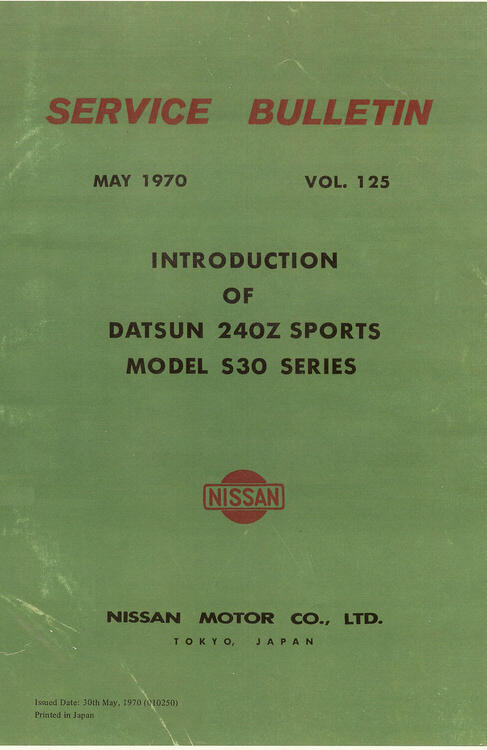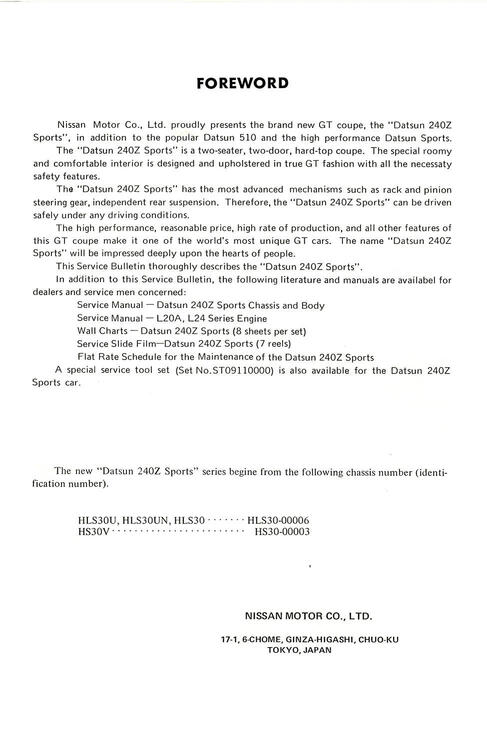Everything posted by Carl Beck
-
Z's on BAT and other places collection
Might have a R200 3.5 or 3.9 ... both desirable today.. Might have a 5spd.. and who knows,might have a good running L-28....
-
Z's on BAT and other places collection
As to a great change or reversal of beliefs, I have to say no. Having spent the better part of 30 years working in the Engineering Design environment of large corp. structures, Mr. Uemura’s story made me feel right at home. I see both Mr. Uemura and his team, as well as Mr. Matsuo and his team in quite a different light than the one you portray. Much more along the lines of the actual work environment; - Take Management Direction, Salute, and Execute. Design A New and More Modern Sports Car For Nissan To Sell. From Mr. Uemura’s story, I see the engineering development team excited and happy to play a part in the development of A New Sports Car that would be put into production. The only conceivable “family” of variants I could think of were created by the Domestic and Export Sales Departments. They had more to do with the definition and range of models, with standard & optional equipment that would comprise the Model Line at the Dealerships. Some quotes from Chapters 2 - Before Development of the Datsun 240Z & 3 - Development of The Datsun 240Z. "At that time, the Styling Section, looking for a design for the new sports car, started preparing for developing the new sports car by building some clay models, including both open and closed models of two-seater cars. The executives, however, did not immediately give their approval for developing the new sports car. Then-president Katsuji Kawamata had a consistent belief: “A sports car is not for making profits but to act as a showcase for our company.” I think that he thought the company did not have to take this sort of risk, because Nissan already had two sports car models: the Datsun Sports and the Silvia. On the other hand, there was a strong desire for a new model in the US market, the Datsun Sports’ main market. This was due to the large number of complaints regarding the existing Datsun Sports, which we were asked to eliminate by bringing out a new model. In Chapter 3 - Development of the Datsun 240Z for example: Mr. Uemura writes "In April 1967, Hajime Suitsu, the Chief Engineer, held a talk with the leaders of the Engineering Department who controlled the production, and they came up with the development course of the new sports car, as follows: a) Development shall be completed in time for shipment in August 1969. b) The retail price in North America shall be 2,546 dollars. c) The car shall be profitable in North America. d) The initial cost shall be estimated on the assumption that 1,000 units will be produced in a month and the cost will be amortized over two years. e) The capacities of the facility shall be 2,000 units per month. f) The base model shall be equipped with a 1600 cc four-cylinder engine. g) As a high-performance specification model, a vehicle equipped with a 2000 cc six-cylinder engine shall be added. h) The new model shall be produced by Nissan Shatai, as with the current Datsun Sports. While the Domestic Sales Department desired a performance car that could compete with the Toyota 2000GT in terms of performance, this set out the basic policy that a profitable new model mainly targeted for the North America market, rather than for hardcore car fans, would be developed. On June 8, 1967, the first liaison meeting for the next-generation sports car was held. A total of about 20 people from the design sections and the modeling, trial production, testing, body and outfitting departments, as well as those from Nissan Shatai who were in charge of development and production were called in for this meeting. They were given the fundamental plan by Suitsu, and the specifications and the layout chart were distributed. In this meeting, he spoke to them, saying, “We will develop three types for this model: a two-seater coupe, a two-seater convertible, and a 2+2 coupe, and give first priority to the two-seater coupe. We would like to make an unconventional car that leads the sports car market by aiming at a top speed of at least 124 mph (200 km).” This served as the formal kick-off in the Design Department. The model was developed following a rigid schedule. For example, the drawings of bulky parts (cast, forged, and stamped parts) had to be released by the end of July, and the first prototype vehicle be completed by the end of November. Suitsu gave us a pep talk, saying, “If it’s difficult to meet a deadline, don’t struggle with it alone. Talk with me and we will hammer out ways to deal with it.” - end quotes - - - The Book was priced at a very low price point - so every enthusiast could easily afford to enjoy it. https://www.lulu.com/search?page=1&q=Datsun+240Z&pageSize=10&adult_audience_rating=00
-
Z's on BAT and other places collection
Hi Kats: I think Mr. Uemura and his team's pride and passion for their work comes though even in the translated story. Mr. Motomura had the same feelings. Talking personally to someone about an experience is one thing, where you have not only words, but tone, body language and immediate feed back from the listener. Capturing the perfect words to convey that emotional attachment in writing is quite a different task. To an extent that is why some people are Literature Majors / Best Selling Authors and others are Science & Math Majors. In spit of the fact that it is difficult for hard nosed engineers and craftsmen driven by science, technology and mathematics to write a report that also conveys their emotions; I personally felt that Mr. Uemura and Mr. Motomura did an excellent job. Everyone should read the story for themselves, however it was easy for even me to recognize the pride and emotional motivations helping to drive their work.
-
Z's on BAT and other places collection
This is interesting... Going to Auction - read the article.. https://www.thedrive.com/news/the-porsche-959-nissan-bought-to-engineer-the-r32-gt-r-is-going-to-auction?utm_campaign=socialflow&utm_source=facebook&utm_medium=social
-
Z's on BAT and other places collection
I do not believe that anyone so far has actually referred specifically (intentionally) to the Series as "defining content and specifications" of any specific model. You are correct, it doesn’t nor is it intended to. It is actually intended to be a specific starting point for finding the content and spec’s for a specific model. A definition of “series”: a number of things, events, or people of a similar kind or related nature coming one after another. So if “S30” is the name of a series, there has to be more than one model in that Series.(otherwise it isn’t a “series”) So what comprises the "S30 Series" of Nissan Sports Models 1969 through 1973? Domestic Models S30S, S30, PS30, PS30-SB. HS30 and Export Models HS30, HLS30 To find all the content and specifications for any specific Model in the S30 Series, you have to direct your attention to the specific technical documents provided by Nissan for that specific model. If say you have HLS30 159035 - you may need the 1973 Factory Service Manual as well as the associated Factory Service Bulletins, and a Parts Catalog that included the 1973 models. So the complete VIN gives you the starting point. You have to know the specific model, before you can find all the information published about it. Series I Datsun 240Z - you need the 1970 Factory Service Manual etc. Series II Datsun 240Z - you need the 1971 Factory Service Manual etc. Mr. Uemura has an interesting discussion in his Book related to Models. From Mr. Uemura’s description: Chapter 3. Vehicle Type, Cost, and Weight page 43. (summary..cjb) Domestic Specification "In the end, we established a number of models, in same way as our general passenger cars.” I. Standard Specification Model (S30-S) II. Luxurious Specification Model (S30) III. High-speed Specification Model (PS30) IV. Race Specification Model (PS30-SB) Export Specification: Three types of models were available for export specifications: the North American specification (HLS30-U), the left-hand drive specification for general export (HLS30), and the right-hand drive specification for general export (HS30). The first priority was given to the development of the vehicle for North America, which was the largest market. Fundamentally, the general export specification vehicle was the same as that of the North American specification, but some safety and emissions equipment were omitted. https://www.lulu.com/search?adult_audience_rating=00&page=1&pageSize=10&q=Datsun+240Z
-
Z's on BAT and other places collection
We should not conflate the two distinctly different actions related to changing a specific Part within a Model, and changing the Model. Changing a part and/or associated Part Number within a currently produced Model can be done for many reasons. The part may have been improved but retains the same form, fit and function. The part supplier may have been changed. A newer part with the same form, fit and function can supersede an older part number on an older model to consolidate or replenish Service & Repair parts inventory None of these individual part changes, change the current Model. Manufactures change the Model, as they introduce the next year’s New and Improved Model. When Nissan changed their Model, they issued Technical Service Bulletins documenting what changes they made between the Old and the New model. With the introduction of new model, they issued Introductory Service Bulletins, New Technical Service Manuals in support of the new model and updated Technician Training Materials.
-
Z's on BAT and other places collection
- Z's on BAT and other places collection
The last Series I 1971 240Z's were produced in Jan. 1971. The Series II 1971 Late Model 240Z's started production in Feb. 1971. VIN's starting at HLS30 21001. Nissan published New Model Introduction service bulletins that identified the 17 specific improvements in Customer Safety, Connivence and Performance items all offered on the second 1971 model offered for 1971.- Z's on BAT and other places collection
According to Nissan - they identified every 240Z sent to North America with both a vehicle identification code and a chassis serial number. Further Nissan started a new series of chassis serial numbers for each new model and documented that in their Factory Service Bulletins. The first series of chassis serial numbers started at HLS30 00006 and HS30 00003 The second series of chassis serial numbers started at HLS30 21001 and HS30 00501.- Z's on BAT and other places collection
I beg to differ. Cause and Effect at play in this case. The Cause: Nissan sent two different models of the Datsun 240Z to North America and sold them both as 1971 Model Year vehicles in calendar year's 1970 and 1971. This was NOT normal practice in North America. The Effect: Series I / Series II is the direct effect of the consumer confusion caused by Nissan Motor Co. Ltd. “Which 1971 240Z Do You Have?” That was one of the first questions prospective buyers had to ask of the seller back in the mid 1970's, when they saw a "1971 Datsun 240Z" advertised for sale in classified Ad's. We still see people asking “is my 240Z a 70 or a 71?" today 50+ years later. If anything, the need for a term that would clearly identify which 1971 Datsun 240Z was being offered For Sale - was lessoned during the internet age. Because then seller could easily provide clear pictures with the Ad. and potential buyer would know which 1971 was being offered.- Z's on BAT and other places collection
Does this count as "A Z Car In A Movie"? Tom Cruise isn't quite Steve McQueen yet... so it will be interesting to see what premium a direct association with Tom Cruise is worth. Anything directly associated with Steve McQueen seems to carry a 10x premium... 10 or 20 years from now with a different generation buying - Tom Cruise may be assigned the same premium... $50K car today might be a $500K car ten to twenty years later....- Where oh Where has Zedyone been?
Hi Zedyone - -WOW! "Subsystem Manager for Propulsion” on the Artemis Crew module (that is still Orion right?) . Congratulations: that is a huge vote of confidence from both your Technical and Management chains. I’m sure you will do an outstanding job. (although it can come with an increased level of stress). Also great write-up on keeping that 53 year old Z on the road. Lots of useful information there for all of us.- Z's on BAT and other places collection
Another link - some amazing Z's... https://www.mecum.com/videos/the-st-yves-datsun-nissan-collection-mecum-kissimmee-2024/?fbclid=IwAR0QDyChMOcEkXUzE7oQyUJQH6eceyWdy7AohIJ8Du-73GRTBOiPmWHjfe8- 1970 240z in Pewter $2k
Any known history? Carl- Z's on BAT and other places collection
That is a very strong offer - and looking forward I don't see the market getting stronger any time soon.- Z's on BAT and other places collection
Has anyone been watching Hagerty Auctions? https://www.hagerty.com/marketplace/auction/hGKn8rHytYkjYUULAJlnh?fbclid=IwAR0MD8_76rmoDK-kIyAPyuPwq4adRbQQ1efNcrX70h6a0GXZ9meozisyOgQ- Z's on BAT and other places collection
A 1972 sold for $25,500.00 on BAT - in better shape - although it is an A/T. This 71 is going to need a repaint and new Dash, seats etc. etc... In todays market I'd say this 71 should be closer to the $18K to $20K range. 18 months ago it would have been snapped up at $25K... not today... https://bringatrailer.com/listing/1972-datsun-240z-283/- Let's show vintage racing pictures. I'll start.
You could have bought it last week - https://bringatrailer.com/listing/1974-datsun-260z-race-car/- Z's on BAT and other places collection
EBay - 22 Oct. 2022 - - asking $149,000.00 bid to $50K RNM Actually looks pretty nice - just non-numbers matching...- Z's on BAT and other places collection
Coming up at Mecum: Fast Z ? https://www.mecum.com/lots/1093787/1971-datsun-240z-custom-roadster/- Aerodynamic Study: Spoilers & Blunt Nose and Under cover
Hi Roo Question: - - 58.674 bhp - - per what? What is "aero power" or how does that relate to engine HP? thanks, Carl- Z's on BAT and other places collection
If you are in the area... https://www.ararityauctions.com/auctions/1189379383/barn-find-1971-datsun-240z- Aerodynamic Study: Spoilers & Blunt Nose and Under cover
I believe that they caused vibrations only in a specific RPM range - AIR the test team driver said he needed to maintain a certain specific higher speed range long enough for the vibration to show up and get worse. Slower or faster was not a problem.- Aerodynamic Study: Spoilers & Blunt Nose and Under cover
Hi Kats: As I understand it: GT Class is Grand Touring Sports Class “F” Engine Size is: 123 CID (2015.61cc) to 183 CID (2998.83 cc) 152.134 mph 1972 (L24 BRE Front Spook and Rear Spoiler) 166.037 mph 1976 (L28 G Nose with chin spoiler) 168.721 mph 1985 (308QV Ferrari) 172.974 mph 2010 (L28 - Rebello 3.0L - slight body rake) Between 152 mph and 166 mph two things changed. 1) L24 to L28 and 2) BRE/Spook/spoiler changed to G Nose. I have to think that the L28 accounted for the additional speed. A Wild Guess - about setting the Z on blocks: There could be a significant difference between the Wind Tunnel in Japan 1971 and the one used by HybridZ in 2008 was it? The Wind Tunnel in Japan may have had a limited number of sensors spaced in the floor - so the Z there was set on blocks - on the sensors. The Wind Tunnel used by HybridZ has sensors more easily movable / or more of them in the floor - so the tires could set directly on them.- Aerodynamic Study: Spoilers & Blunt Nose and Under cover
@SpeedRooThanks - the old links in my bookmarks wouldn't load.... so I used the image I had saved at the time. - Z's on BAT and other places collection
Important Information
By using this site, you agree to our Privacy Policy and Guidelines. We have placed cookies on your device to help make this website better. You can adjust your cookie settings, otherwise we'll assume you're okay to continue.







